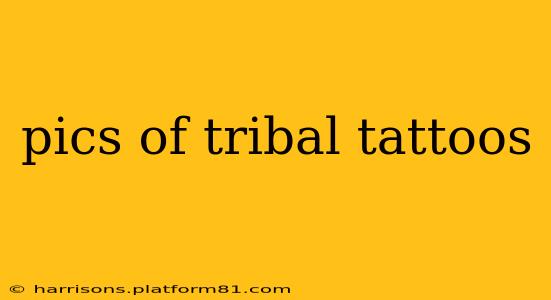Tribal tattoos, with their rich history and powerful symbolism, have captivated people for centuries. From ancient Polynesian designs to contemporary adaptations, these intricate works of art tell stories, represent cultural heritage, and showcase individual identity. This exploration delves into the world of tribal tattoos, examining their origins, diverse styles, and the meaning behind their captivating imagery.
What are Tribal Tattoos?
Tribal tattoos are a broad category encompassing body art that originated within various indigenous cultures around the globe. While often associated with Polynesian, Maori, and Native American designs, the term encompasses numerous traditions, each with its unique aesthetic and symbolic language. These tattoos weren't merely decorative; they served crucial roles in marking social status, spiritual beliefs, and lineage within a community. The intricate patterns and bold lines often represent animals, spirits, or significant natural elements, each holding deep cultural significance.
What are the different types of tribal tattoos?
The beauty of tribal tattooing lies in its diversity. Different cultures developed distinct styles reflecting their unique histories and beliefs. Some prominent examples include:
-
Polynesian: Known for their intricate geometric patterns, bold lines, and use of black ink, Polynesian tattoos, or tatau, often depict gods, ancestors, and important figures. The designs are often highly personalized, reflecting the individual's story and status within their community.
-
Maori: Maori tattoos, or tā moko, are deeply significant in Maori culture of New Zealand. These tattoos, traditionally carved into the skin using chisels, are often elaborate and cover large areas of the body. They convey genealogical information, social standing, and spiritual beliefs.
-
Native American: Native American tribal tattoos vary greatly across different tribes and nations. Designs often feature animals, natural elements, and symbols with specific meanings relevant to the tribe's traditions and beliefs. The use of color and style varies considerably.
-
African: African tribal tattoos boast an incredibly diverse range of styles, reflecting the continent's many cultures and traditions. Common motifs include geometric shapes, animals, and spiritual symbols, often used to signify initiation rites, marriage, or social status.
-
Modern Tribal: Contemporary artists have taken inspiration from traditional styles, creating innovative designs that blend traditional elements with modern aesthetics. This often involves adapting traditional motifs into more abstract or stylized forms, allowing for greater individual expression.
What do tribal tattoos symbolize?
The symbolism within tribal tattoos varies drastically depending on the culture of origin and the specific design. However, some common themes emerge:
-
Strength and Courage: Many tribal tattoos depict powerful animals or symbols representing strength, resilience, and courage.
-
Protection and Spirituality: Certain designs are believed to provide spiritual protection or connect the wearer to ancestral spirits.
-
Identity and Lineage: The tattoos often serve as markers of identity, indicating lineage, social status, or clan affiliation.
-
Spiritual Journeys: Some designs symbolize significant life events or spiritual journeys.
Where are the best places to get a tribal tattoo?
Choosing a tattoo artist is a crucial step in getting a tribal tattoo. It’s essential to find an artist with extensive experience in this style, who understands the cultural significance of the designs and can create a meaningful piece that respects the tradition. Research reputable artists in your area and look at their portfolios to ensure their style aligns with your vision. Reviews from other clients can also be valuable in making your choice.
How much does a tribal tattoo cost?
The cost of a tribal tattoo varies significantly based on factors such as the size, complexity, and detail of the design, as well as the artist’s experience and location. Smaller, simpler designs will be less expensive than large, intricate pieces requiring many hours of work. Always get a detailed quote from your chosen artist before proceeding.
Are tribal tattoos painful?
Pain tolerance is subjective, but tribal tattoos, especially larger or more detailed ones, are often perceived as more painful due to their intricate linework and placement on areas of the body with more nerve endings. Your artist can provide guidance on managing discomfort and minimizing pain.
How long do tribal tattoos take to heal?
The healing time for a tribal tattoo depends on several factors, including the size of the tattoo, its depth, and proper aftercare. Most tribal tattoos will require several weeks to heal fully. Following your artist’s aftercare instructions diligently is crucial for proper healing and avoiding complications.
This exploration provides a glimpse into the fascinating world of tribal tattoos. The art's enduring power lies in its ability to bridge cultures, preserve history, and express individuality through a potent blend of tradition and personal expression. Remember, responsible research and a respectful approach are vital when choosing to adorn your body with this powerful form of art.
